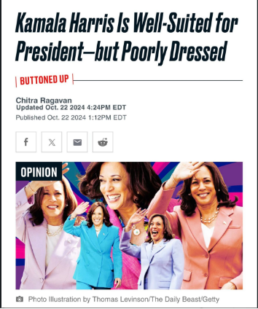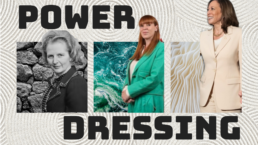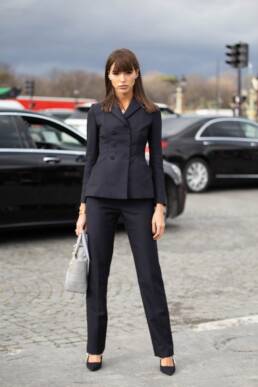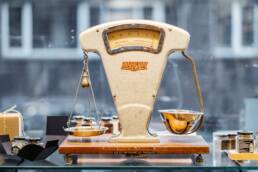women in power : owning the narrative and the suit
Social media is relentless in its scrutiny of women, judging how they present themselves. For women in positions of authority, dressing to sidestep this scrutiny becomes a strategic necessity.
Look at Kamala Harris as she powers her way through rallies, debates and conferences in her trademark ‘pantsuit’, as Hillary Clinton did before her, or Rachel Reeves here in the UK as the first woman chancellor. It’s perhaps the simplest solution when moving in the corridors of power and dressing in anticipation of a position that has, until now, required only menswear.
Yet, even if you adopt the jacket and trousers style, you may still find yourself at the mercy of the trolls,as presidential candidate Harris has found, with comments such as the Daily Beast saying she is “more than ready” to become US president, but that she has “failed to leverage one of the most powerful communication tools for female leaders: her sense of style.

And long before the news broke that thousands of pounds worth of clothing for the new Labour cabinet had been funded by a donor, the new deputy prime minister Angela Rayner and her colleagues found themselves in the firing line when they entered Downing Street for their first cabinet meeting.
The wrong colour, the wrong shape, the wrong price point for a working class woman (seriously? although that became trickier once we knew someone else was footing the bill). So many sins: and it was only a suit.
Other voices argue that ‘borrowing’ suits demonstrates women are just ‘borrowing’ power.
We disagree – this all comes down to sexism.
As former editor of Vogue, Alexandra Shulman, said in an interview with The Times: “We can buy clothes at all sorts of prices but we wear uniforms. There is still a prevailing notion of what a woman should look like at work, what should be projected to be successful. … You have to wear what is expected: a black skirt, sleeveless shift dress. In lots of places women are in charge but they still wear (what is expected).”

Women shouldn’t need to wear a uniform, but wearing a suit can help to divert the narrative away from what you are wearing to what you are saying.
The flack that hit Angela Rayner and other members of the new Labour cabinet as they rocked up to serve their country reminds us how little progress we have made in the 45 years since Margaret Thatcher became the UK’s first woman prime minister. She was the archetypal power-dressing woman, with her skirt suits and trademark pussy cat bow blouse, mirroring her male colleagues with a feminine version of their suits and ties. That, and her deliberately deepened voice made her appear to conform, although her role as leader was evidence that she was actively subverting the traditional boys’ club atmosphere of the Tory party of the time.
In many ways, Kamala Harris has a tougher path ahead than women politicians here in the UK: if elected, she will be the first woman president of the United States. Her track record on the fashion front suggests the pantsuit will remain the centrepiece of her wardrobe, and if Hillary Clinton’s experience is anything to go by, it’s a safe option as it avoids attempts at ‘upskirting’. (Yes, really, that’s reportedly why Clinton stopped wearing skirts).
But one article we came across, by an academic specialising in the field of masculinity, raises some challenging views around this topic. They argue that suits are cut for men and difficult for women to wear.

Since when could women not rock a suit? And since when were women’s suits not cut to fit women? For decades, women’s suits have responded to fashion trends, most recently appearing in a serving of irresistible bright colours, while still maintaining their place as a key component of the power wardrobe.
Looking at US Presidential candidate Kamala Harris or UK Chancellor Rachel Reeves, each in their trademark sharp suiting, it’s hard to imagine anyone agreeing with the statement that: “there is no single garment, or group of garments that can give women the same, or similar gravitas, that men’s suits give men”.
And the suggestion that women do not own their power cannot possibly withstand the force of Angela Rayner’s bright green option. That suit demands attention, which surely was the intention, putting her in the spotlight as she strode into power.
- Let’s focus on profiling women for their action and achievements not their outfits : that’s our aim at This is LUMIN and if you have any ideas for interesting interviewees, whatever their fashion style, we’d like to hear from you.
Author

This is LUMIN
Editorial from our writers and contributors towards our common goal: raising awareness of the issues that matter to women who want to drive greater success for all, in the world of work and in business
Related Posts
the work-life balancing illusion
We talk a lot about work-life balance, but for many women, the ‘life’ side of…
07/03/2025life,wellbeing,careerssolopreneurship,gender equity,domestic load,productivity,sustainability,multitasking myth,women entrepreneurs,work-life balance,burnout
the power of saying no
Just because you can, doesn’t mean you should. For many women, saying no…
27/02/2025business,wellbeing,careersavoiding burnout,personal development,self employment,saying no,setting boundaries,time management
tackling the march of macho leadership
The march of macho leadership seems unstoppable. How can we foster genuine…
26/02/2025mission,careersElon Musk,Signalling Authenticity,dictatorships,leadership,women in leadership,Vladimir Putin,Donald Trump



